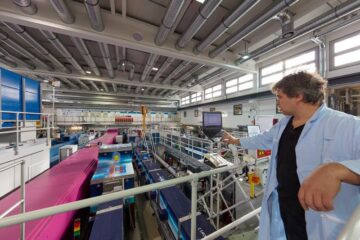Analysis of Molecules Confined by Graphenes

<p><strong>Background</strong><br>
Few methods are able to analyze single molecules. Analysis problems occur due to the instability of thin molecular layers and especially single molecules with respect to their thermal-, chemical- and photo-degradation or to external mechanical fields caused scanning probe techniques. A disadvantage of Raman scattering methods is the large amount of heat produced by the focused plasmons localized at the active site, which can cause damage of the molecules. Graphene exhibits plasmon resonance in the ultraviolet and blue spectral region and thus can enhance Raman signals. Graphene is a monoatomically thick and flexible layer, which provides thermal and electrical conductivity as well as high optical transparency and impermeability to gases and liquids. Thus graphene can act as protective layer against local heating.<br><br> <!–break–><strong>Technology</strong><br> This novel method allows the analysis of substances in very small quantities, even single molecules, with common techniques. The substances to be analyzed are covered with a graphene layer. <br> <br> <strong>Benefits</strong><br> <ul> <li>Precise profiling with protective graphene layer</li> <li>Profiling analysis of single molecules, soft and instable molecules, DNA, thin layers and self-assembled monolayers (SAMS)</li> <li>Protection and conservation of molecules from interaction with atmospheric oxygen</li> </li> </ul><br> <strong>IP Rights</strong><br> US patent application (03/2011)<br> PCT application <br> <br> <strong>Patent Owner</strong><br> Humboldt-Universität zu Berlin, Germany<br> PlasmaChem GmbH, Germany</p>
Weitere Informationen: PDF
ipal GmbH
Tel.: +49 (0)30/2125-4820
Ansprechpartner
Dr. Dirk Dantz
Media Contact
Alle Nachrichten aus der Kategorie: Technologieangebote
Neueste Beiträge

Bakterien für klimaneutrale Chemikalien der Zukunft
Forschende an der ETH Zürich haben Bakterien im Labor so herangezüchtet, dass sie Methanol effizient verwerten können. Jetzt lässt sich der Stoffwechsel dieser Bakterien anzapfen, um wertvolle Produkte herzustellen, die…

Batterien: Heute die Materialien von morgen modellieren
Welche Faktoren bestimmen, wie schnell sich eine Batterie laden lässt? Dieser und weiteren Fragen gehen Forschende am Karlsruher Institut für Technologie (KIT) mit computergestützten Simulationen nach. Mikrostrukturmodelle tragen dazu bei,…

Porosität von Sedimentgestein mit Neutronen untersucht
Forschung am FRM II zu geologischen Lagerstätten. Dauerhafte unterirdische Lagerung von CO2 Poren so klein wie Bakterien Porenmessung mit Neutronen auf den Nanometer genau Ob Sedimentgesteine fossile Kohlenwasserstoffe speichern können…

















